Table of Contents
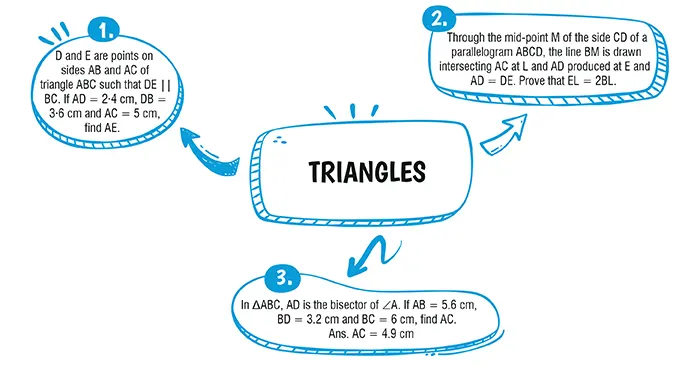
Ans. (b)
Explanation:
Since PS is the internal bisector of ∠P and it meets QR at S image.
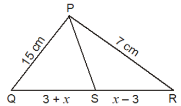
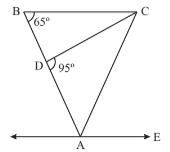
Ans. (d)
Explanation:
Given that, BC || AE
∠CBA + ∠EAB = 180°
⇒ ∠EAB = 180° – 65°
= 115°
BC = AC
Hence, DABC is an isosceles triangle.
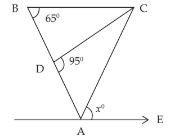
⇒ ∠CBA = ∠CAB
= 65°
Now, ∠EAB = ∠EAC + ∠CAB
⇒ 115° = x + 65°
⇒ x = 50°.
Explanation:
Given, DE || BC, AD = 2.4 cm, DB = 3.6 cm and AC = 5 cm
In ΔABC, DE || BC
\therefore \dfrac{AD}{DB}=\dfrac{AE}{CE} \\[4 bp] \text{[by basic proportionality theorem]} \\[4.5 bp] \Rightarrow \dfrac{AD}{DB}=\dfrac{AE}{AC-AE} \\[5 bp] \Rightarrow \dfrac{2.4}{3.6}=\dfrac{AE}{5-AE} \\[5 bp] \Rightarrow \dfrac{2}{3}=\dfrac{AE}{5-AE} \\[5 bp] \Rightarrow 3AE + 2AE = 10 \\[5 bp] \Rightarrow AE = \dfrac{10}{5} \\[5 bp] \Rightarrow AE = 2 cmExplanation:
In ∆BMC and ∆EMD, we have

∠1 = ∠2 [Vertically opposite angles]
MC = MD [M being the mid-point of CD]
∠BCM = ∠EDM [Alternate angles]
Thus ∆BMC ≅ ∆EMD [by ASA] \\ \Rightarrow BC = DE (cpct)
Again, BC = AD [Opposite sides of the parallelogram ABCD] \\ \therefore BC = AD = DE
So, AE = AD + DE = 2BC …(i)
Again, in ∆AEL and ∆CBL, ∠5 = ∠6 [Vertically opposite angles]
∠3 = ∠4 [Alternative angles]
So, ∆AEL ~ ∆CBL
\\ \therefore \dfrac{EL}{BL}=\dfrac{AE}{BC}=\dfrac{2BC}{BC}=2 [From (i)]Thus, EL = 2BL.
Explanation:
Given, AD is the bisector of ∠A.
Thus, ∠BAD = ∠CAD
Now BC = BD + DC
⇒ 6 = 3.2 + DC ⇒ DC = 2.8 cm
⇒ 6 = 3.2 + DC
⇒ DC = 2.8 cm
Since AD is the angle bisector of ∠A,
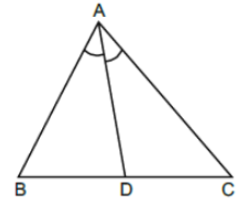
Hence \\ \dfrac{DB}{DC}=\dfrac{AB}{AC} \space \space \text{[Angle bisector theorem]} \\[4.5 bp] \Rightarrow \dfrac{3.2}{2.8}=\dfrac{5.6}{AC} \\[4.5 bp] \Rightarrow AC = \dfrac{5.6×2.8}{3.2} = 4.9\space cm.
| Chapter No. | Chapter Name |
|---|---|
| Chapter 1 | Real Numbers |
| Chapter 2 | Polynomials |
| Chapter 3 | Pair of Linear Equations in Two Variable |
| Chapter 4 | Quadratic Equations |
| Chapter 5 | Arithmetic Progressions |
| Chapter 6 | Triangles |
| Chapter 7 | Coordinate Geometry |
| Chapter 8 | Introduction to Trigonometry |
| Chapter 9 | Some Applications of Trigonometry |
| Chapter 10 | Circles |
| Chapter 11 | Areas Related to Circle |
| Chapter 12 | Surface Areas and Volumes |
| Chapter 13 | Statistics |
| Chapter 14 | Probability |
| Chapter Wise Important Questions for CBSE Board Class 10 Maths |
|---|
| Real Numbers |
| Polynomials |
| Pair of Linear Equations in Two Variables |
| Quadratic Equations |
| Arithmetic Progressions |
| Triangles |
| Coordinate Geometry |
| Introduction to Trigonometry |
| Some Applications of Trigonometry |
| Circles |
| Areas Related to Circles |
| Surface Areas and Volumes |
| Statistics |
| Probability |
CBSE Important Questions Class 10
ICSE Important Questions Class 10
CBSE Important Questions Class 10
ICSE Important Questions Class 10